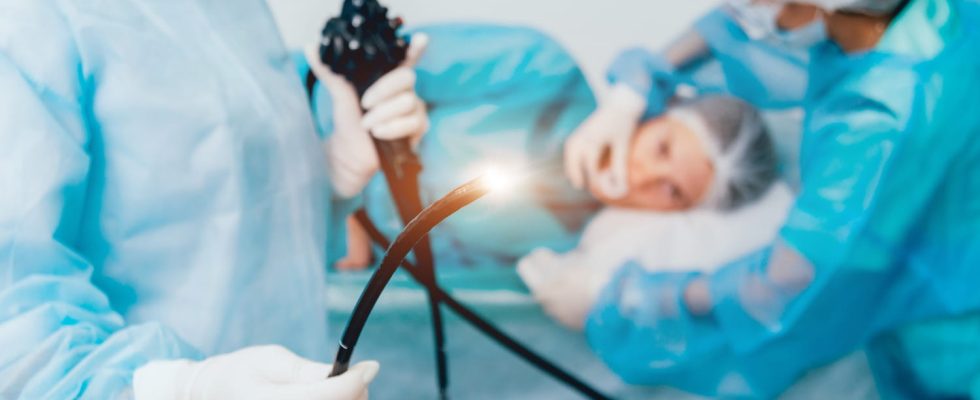Endoscopic examination of the upper digestive tract, gastroscopy also called “gastric fibroscopy” is indicated in cases of reflux and stomach pain.
The two main indications for a gastroscopy are gastroesophageal reflux disease (GERD) in order to assess possible damage to the esophagus and stomach pain. “In this case, we can find a inflammation called gastritis or ulcer, which has become much rarer. But the field of indications is very vast, including all digestive symptoms, whether esophageal or gastric (difficulty swallowing, anemia, weight loss, absorption disorders, celiac disease). explains gastroenterologist Dr Philippe Godeberge.
Definition: what is a gastroscopy?
Gastroscopy is the reference examination which allows, thanks to a fiber device equipped with a camera (the endoscope), toexplore the walls of the upper part of the digestive tract: esophagus, stomach and duodenum (the beginning of the small intestine). “The terms of gastric fibroscopy or upper digestive endoscopy are synonymous. The endoscope is introduced through the mouth and follows the natural path of the digestive tract; it allows small samples to be taken from this wall (biopsies)”comments Dr Philippe Godeberge.
What is the difference between a gastroscopy and a fibroscopy?
A fibroscopy is a medical examination allowing you to visualize the inside of the body. Gastroscopy is located specifically at the upper part of the digestive tractwe also talk about “upper digestive fiberoscopy”, A gastroscopy is carried out with a flexible endoscope called a “gastric fiberoscope”. “The correct term should be esophagogastroduodenal fibroscopy“, underlines Dr Philippe Godeberge.
Should you fast?
The stomach must be empty. It is therefore necessary to strictly fast and not drink, eat or smoke. during the 6 hours preceding the exam. It is advisable to do not smoke 2 days before.
General or local anesthesia?
Gastroscopy is performed under general or local anesthesia. The patient lies on his side. The gastroenterologist inserts the endoscope, which measures less than 10mm, through the mouth. “It controls the movement using handles at the base of the device and carries out theexamination via a screen where the images coming from the miniature camera are displayed fixed at the end, notes the gastroenterologist. The exam is feasible without anesthesia, under simple anesthesia of the throat, but tolerance is often less good (nausea).”
How long is it ?
The actual exam only lastsabout ten minutes. But the stay on site is longer, because of the installation, monitoring during and after the examination. Because of the anesthesia, you have to go home accompanied and you cannot work afterwards.
Results
Gastroscopy allows the diagnosis of almost all diseases of the upper part of the digestive tract, particularly cancers or precancerous lesions. Diagnosis usually requires biopsies, the results of which are obtained within a few days. “Attention, the examination is only complete if we have both reports, that of the fibroscopy and that of the biopsies, warns Dr Philippe Godeberge. These can also highlight a bacteria called Helicobacter Pylori, responsible for inflammation treated with specific antibiotics. The examination may be normal, even despite intense symptoms, which may reflect a benign functional disorder, certainly uncomfortable but without the responsible lesion.“.
Complications and side effects
“Gastroscopy is not a painful examination since it can also be performed without general anesthesia. It is very well tolerated and its complications are very exceptional even if incidents at the time of the examination could be described”, reassures the specialist. These include: dental lesions when the device is inserted, perforation of the digestive wall (very rare), cardiovascular and respiratory problems or even hemorrhage in the event of biopsies or associated procedures. In the days following the examination, fever, abdominal pain and even bloody vomiting were reported.
Thanks to Dr Philippe Godeberge, gastroenterologist, in Paris.
